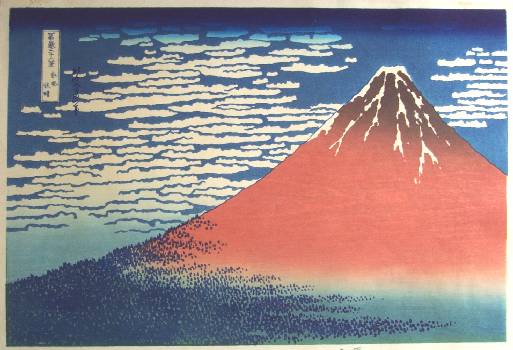A Popular and Often-reproduced Print
Without a doubt, Hokusai's striking "Red Mt Fuji, At Dawn" (actually titled, "South Wind, Clear Dawn" (in Japanese, "Gaifu Kaisei"))
is one of the most widely recognized and most popular prints of all time. This print, along with Hokusai's other masterpiece, the
"Great Wave off Kanagawa," are the two Japanese prints that foreigners everywhere associate with "Japanese art." Many individuals,
no matter how limited their knowledge of world art, will still recognize these two images immediately on sight. In many ways, these two prints
of the 1830's (and both belonging to Hokusai's "Thirty-six Views of Mt Fuji" ("Fugaku Sanju-Rokkei") series) ARE "Japanese art."
So popular have been these two "Fuji" images, that they have understandably been reproduced time and time again over the years. Nearly
every large Japanese woodblock print publisher of the late 1800's or early-mid 1900's has, at one time or another, re-carved and
printed their own reproductions (or "re-strikes") of these prints. Always in demand and sought-after by tourists, these prints have
always sold well and have become a mainstay item of these various Japanese publishing houses. Included are the name of present-day publishers such as
Watanabe, Unsodo, Uchida, as well as earlier publishers of the earlier 1900's such as Adachi and Takamizawa.
An Eye-Catching Copy of Hokusai's "Red Fuji"
Of course, dealing in the volume of Japanese prints that we handle, over the years we have encountered a number of these variously
published "Red Fuji" Hokusai prints. Needless to say, one publisher's copy looks pretty much like any other publisher's copy, as
these Japanese businessmen and the artisans (carvers and printers) that they employ are typically very good at their trade. Of
course, there are some observable differences in quality, but for the most part, as they say, "if you've seen one "Red Fuji,"
you've seen them all."
At least that's what we thought, until a certain "Red Fuji" came our way about a year or so ago...... The "copy" that we're
speaking of is pictured immediately below--and, at first, it too seemed like all the rest. Nothing special, we just set it
aside along with the dozens of other prints that have become our typical inventory of such prints. Upon a later handling however,
something seemed just a "bit different" about this print......
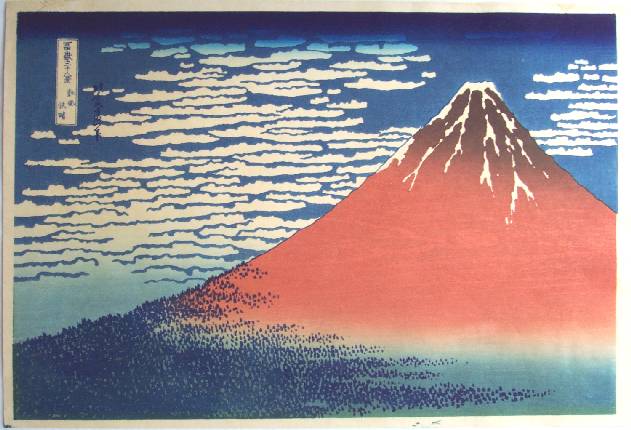
Hokusai's Famous "Red Mt Fuji, At Dawn" Print
Hey, That Looks Like "Woodgrain"....
It turned out that what had finally caught our eye was the fact that THIS particular copy of Hokusai's "Red Fuji" also had a very
distinctive "woodgrain" pattern present across the Mt. Fuji's entire upper red area. This seemed a bit unusual, so we then next
set it along side a Watanabe Publisher's copy for the side-by-side comparison seen just below. Sure enough, the Watanabe copy
was indeed as we'd recalled......with a rather "flat looking" reddish upper mountainside, and clearly LACKING ANY "woodgrain"
pattern.
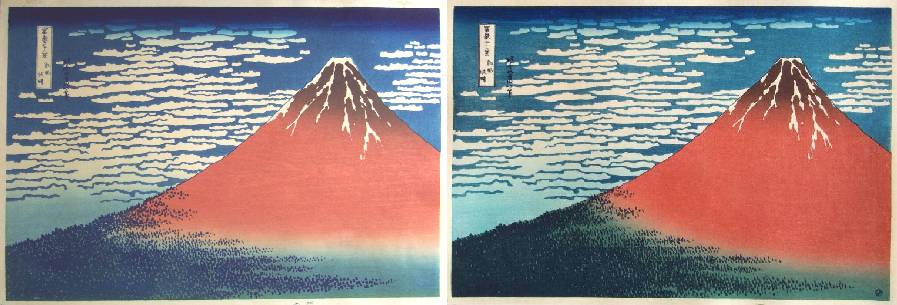
Hokusai's Takamizawa-published "Red Fuji" Print Hokusai's Watanabe-published "Red Fuji" print
Takamizawa Publisher
A closer examination of THIS particular copy of Hokusai's "Red Fuji" (with its distinctive "woodgrain" pattern) soon revealed
across its verso that it's publisher's seal was that of "Takamizawa Mokuhansha." This Tokyo publisher (active 1933-88) was the surviving firm which
was founded by the brothers Masuro and Tadao Takamizawa following the death of their brother Enji Takamizawa, who was known for
having produced astonishingly "look-alike" reproductions during the early 1900's of old 1800's ukiyo-e prints. John Fiorillo's
website speaks in greater detail of this earlier deliberate deception in an article titled
"Deceptive Copies
(by) Takamizawa Enji." The print is shown again below, along with a close-up of its verso-stamped "Takamizawa" publisher's seal.
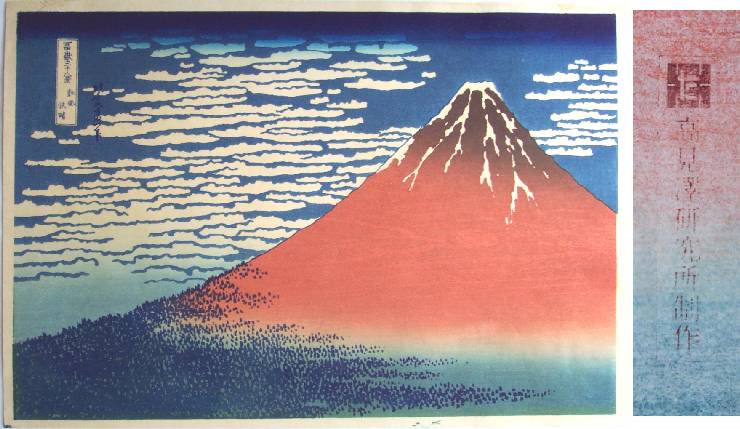
Hokusai's Famous "Red Mt Fuji, At Dawn" Print and verso's "Takamizawa Mokuhansha" Publisher's Seal
In fact, apparently so accurate were some of the earlier Takamizawa reproductions, that various "ukiyo-e experts" of the 1910's and
'20's were occasionally fooled by his reproductions. Ukiyo-e scholar Takahashi Seiichiro is said to have commented that "Takamizawa
was a true genius in his field. 'He proved troublesome to people who were searching for original prints.'" Another respeced
scholar, Tanaka Kisaku, stated that he "couldn't tell Takamizawa's creations from original prints." (Merritt and Yamada;
page 36-37.)
Fellow publisher, Shozaburo Watanabe (founder of Watanabe Publishing, 1906), even himself
spoke harshly and disdainfully of Enji Takamizawa's prints and publishing techniques during these early years (ca1910's)--so
much so that he "considered Takamizawa to be a scoundrel" and refered to him as "the demon of reproduction." (Merritt and Yamada;
page 37.) The point is that Shozaburo felt so strongly about Takamizawa's rather
deliberate attempts at deception that, in a rather non-typical Japanese manner, he even spoke out publicly on this matter.
Of course, it must be recognized that the placement of Takamizawa'a seal ANYWHERE on this print would (at least in this case) not
likely fool any reasonably knowledgable collector as to the vintage of this particular print. Obviously, if Takamizawa had fully
intended to pass this print off as perhaps being a true original, they would have in that case chosen to also leave off their
readily identifiable publisher's information.
Turning to our References
Turning next to our various Japanese woodblock print references, we were eager to see "how closely" Takamizawa's copying of Hokusai's
print's "woodgrain" really was. The "simulation" or re-creation of the original Hokusai print's "woodgrain patten" was actually
rather astonishing.
Compared to two different references, the Takamizawa-published print's "woodgrain" appeared to be right on--nearly identical to
that seen in Hokusai's original 1830-32 print!! Close-ups taken from both references (with an overlaid image of our Takamizawa
print scaled-down and set side-by-side) are show just below. In both cases, note carefully how the SAME strikingly similar "woodgrain
pattern" is seen in both sets of prints.
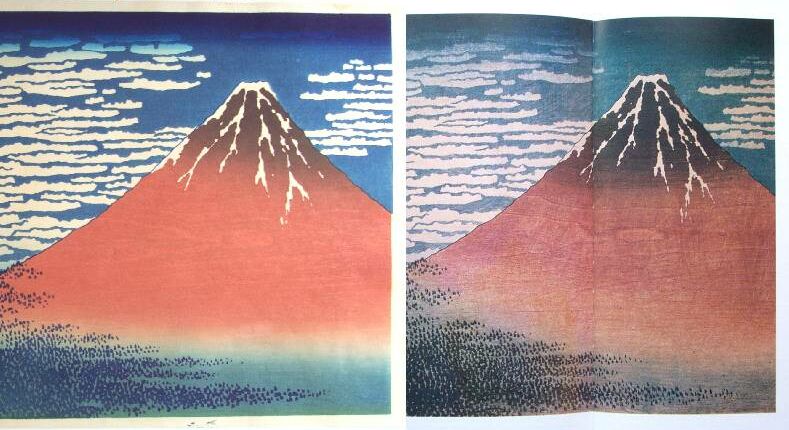
Our Takamizawa "Red Fuji" Print (left) and The "Shinjo Collection's" (Osaka) Print (right)
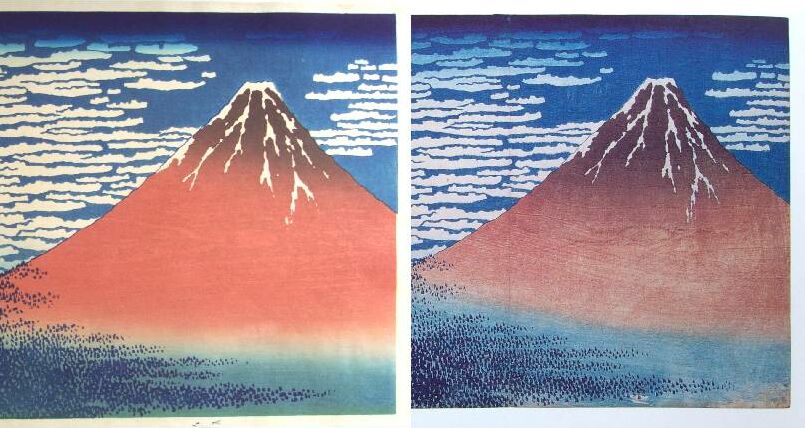
Our Takamizawa "Red Fuji" Print (left) and The "James A. Michener Collection's" (Honolulu Academy of Arts) Print (right)
Woodgrain Patterns are Supposed to be like "Fingerprints"....
But, how could this be??? Why.... we've always assumed that, if present, a woodblock print's unique "woodgrain pattern" was very
much like a person's "fingerprint"--that is, unique and a one-of-a-kind identifier. How then could a print reproduced from a newly
re-carved block of wood during the 1930's or 40's have the SAME "woodgrain pattern" seen in the original Hokusai woodblock of
100-plus years earlier??
Although we certainly cannot say definitively, it is our best guess that Takamizawa "reproduced" the original print's "woodgrain
pattern" through the use of TWO over-laid (over-printed) woodblocks to print the "red area" seen in Mt. Fuji. That is, instead of
simply printing the red using a single "red block" as would have been done in 1830-32 (with the naturally appearing woodgrain left
as a result of printing this smooth-faced "red" block), we believe that Takamizawa cleverly CARVED
the same "woodgrain pattern" OUT OF a second "red block," which was then OVER-printed as a second red pigment layer. Of course, by
this theory, the areas of this second block that were "carved out" did not receive any ink, so the result was only a single, thinner,
lighter-appearing pigmentation in these areas. Hence, the visual "effect" of seeing woodgrain.
At least that's the only reasonable explanation that we can come up with. As for the possibility that Takamizawa's artisans could
have found an UNcarved virgin block of cherrywood with the exact same "woodgrain pattern," we simply do not believe that this would
be possible. In other words, we continue to stand firmly by our believe that--like a human's "fingerprint"--NO two blocks of wood
will ever have the exact same "woodgrain pattern." Those wishing to review another article's example where a known to be original
Hiroshige print's "woodgrain pattern" was similarly used to authenticate a subject print can learn more by reading our 2000
"Recarved Shin Hanga Blocks" article.
Continuing Use of Woodgrain as a "Positive Identifier"
To us at least, the careful use of a print's "woodgrain pattern" REMAINS A POSITIVE IDENTIFER as to a print's authenticity. As we
stated in our earlier 2000 article, "the visible woodgrain pattern seen in ..... prints, like a human fingerprint, is irrefutable.
This is a simple comparison anyone could make; originality and authenticity thusly supported."
In our above Takamizawa example, a typical "closer examination" of the two print's "woodgrain patters" does indeed reveal some
visible differences in the patterns seen. The spacing is just not exactly the same, and other unique differences are seen when
closely comparing both prints.
We will also point out that the rather "flat looking" pattern seen in this "Red Fuji" print is NOT typical of the much more sharp
and distinctive "woodgrain patterns" typically seen, for example, in most of Hiroshige's 1800's prints. If present and visible,
most of these original 1800's
prints will be seen to exhibit very "crisp" and distinctive cherrywood patterns.
One More Example -- A Print from Oedo Mokuhansha Publisher
An additional example of another Hokusai "Red Fuji" re-strike, this time produced by Oedo Mokuhansha Publisher (a Tokyo publisher,
active from ca1950 until present day), is also deserving of mention. This likely 1950's print (printer's name given is that of
Onodera, known to have been active during the 1950's) is shown just below. What makes this print worthy of our attention is the
fact that this print ALSO shows a "distinctively visible" woodgrain pattern in its mountain's upper red area.
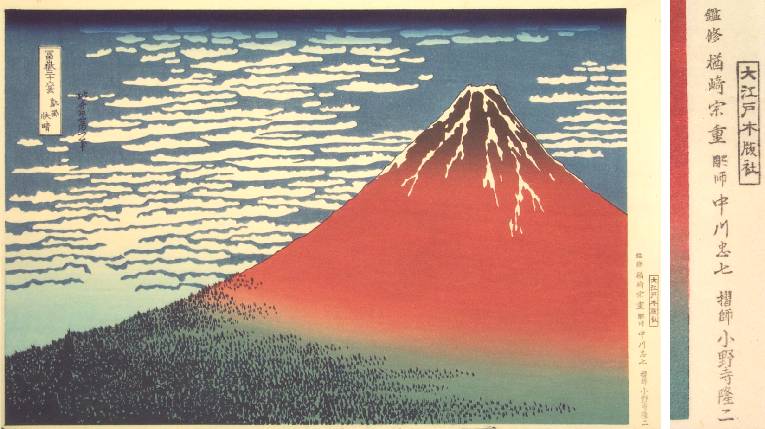
Hokusai's Famous "Red Mt Fuji, At Dawn" Print and margin's "Oedo Mokuhansha" Publisher's Seal
However, at least in this case, here it seems that the presence of "woodgrain" is most likely purely a coincidence. That is, upon
closer examination, it is clear that the woodgrain pattern is running in the OPPOSITE direction as that which is seen in Hokusai's
well-documented, original print. In other words, clearly no deliberate attempt here was make to deceive.
A Few Concluding Remarks
Clearly, as this Takamizawa "Red Fuji" example has shown us, the collector of Japanese prints must at all times remain vigilant
and open to the possibility that a given print may, in fact, be a reproduction. Japanese publishers and the artisans that they
employ certainly are capable at times of producing "believable-looking" reproductions of original prints--so "real" in fact, that
some collectors may be fooled. To guard then against this possibility, what is needed is a sharp eye, a questioning mind, and a
lot of common sense.
Literature (and print) sources used in preparation of this and other articles include:
Above documented prints courtesty of: Ukiyoe-Gallery
"Guide to Modern Japanese Woodblock Prints: 1900-1975", by Helen Merritt and Nanako Yamada, University of Hawaii Press, Honolulu, ISBN 0-8248-1732-X
"Kawase Hasui -- The Complete Woodblock Prints", by Kendall H. Brown & Shoichiro Watanabe, Hotei (KIT) Publishing, Netherlands, ISBN 90-74822-46-0
"Crows, Cranes and Camellias: The Natural World of Ohara Koson", by Amy Reigle Newland, Jan Perree, Robert Schaap, Hotei (KIT) Publishing, Netherlands, ISBN 90-74822-38-X
(c) Thomas Crossland and Dr. Andreas Grund, January, 2004
Gallery
Terms
Ordering
About Us
We Buy Prints
Library
